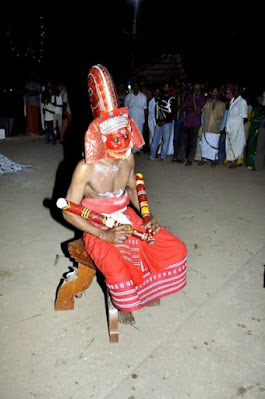POTTAN THEYYAM
‘Pottan’ in Malayalam means
an insignificant, timid fellow with almost no common sense. Of course, it’s a
derogatory word and it’s an insult if you address anybody with the adjective.
Interestingly enough, the
origin of ‘Pottan Theyyam’ dates back to 712 CE, when Adi Shankaracharya was
just 12 years old. He was already a Sanyasi and living near to Kashi (Benares) Viswanatha
Temple. As everybody knows, he is the propounder of the Adwaita Philosophy which
said “All Is One”.
One morning he set out to
take his bath at the river Ganges. On the way he saw a Chandala (untouchable
who is out of the caste system, lesser than “shudra”) accompanied by four dogs coming
against him. Even lower-caste people can’t afford to come inside of the
view-area of the Brahmins! The backward
caste had to run for cover! However, this non-chalant Chandala walked straight
towards the upper-caste Sanyasi.
“Go away, Pulapottan;
keep distance”
Shankaracharya was quite
furious.
“Whom are you asking to
move away, Sir?” the Chandala retorted,
“ To this body of mine
which constitutes of the same five elements as that of yours? It has the same
functions as that of your Brahmin body, don’t you see?”
“Or are you asking my
soul which is the same as that of your soul?
Both are, in fact, the
one and the same Brahman itself”
 |
Pottan Theyyam
|
Shankaracharya was
stunned! He didn’t have an answer.
“You keep teaching about
the undivided, non-dual Brahman, don’t you?
You emphasise that
Universal Consciousness is the substratum of all Creation.
You also teach people
that Consciousness is ever-pure and unpolluted.
However, you are not
convinced yourself, Sir!”
“All I can see that you’re
deprived of the Knowledge!”
The Chandala concluded.
At this stage,
Sankaracharya did ‘sashtanga-namaskar (falling flat on someone’s feet, lying horizontally)
and begged for forgiveness.
It was Lord Shiva in
disguise, testing Shankara’s sincerity and Knowledge!
After blessing the Acharya,
Lord Shiva disappeared.
Taking the cue, Shankaracharya
wrote detailed treatise on the four Vedas & Upanishads and Brahmasutra (the
gist of the Vedas).
Now, we can draw the parallels.
 |
Pottan Theyyam rests on burning embers
|
In the Pottan Theyyam
episode also, Sankaracharya has got the pivotal role.
The Jagat-Guru was on the
way to Thalakkaveri, in Karnataka to climb ‘Sarvajnapeedom’ (Throne of
Knowledge). At a place named ‘Pulingom’ in Kannur he had a brief stopover at
the Shankaranarayana Temple where he gave a lecture to the bhaktas
assembled. The subject, no doubt, was Adwaita Philosophy. A Dalit youth named Alankaran
overheard the entire discourse sitting at the slop of the nearby hillock. (Of
course, he was not allowed to enter the temple). The next morning when Shankaracharya
resumed his journey to Thalakkaveri, Alankaran accosted him piss-drunk!
An angry Shankaran
yelled,
“Thiri thiri thiri thiri
Pulaya
Thiri thiri thiri thiri
Vazhi thari Pulaya”
meaning “Get out of my
way, you wretched”!
The Dalit youth was in no
mood to do that. He argued,
“Engale kothiyalum
chorayalle Chovvare,
Neegale kothiyalum chorelle
Chovvare
Pinnenthu theendikkondu
kulam pisakkunnu?”
If I bleed your goodself,
you have blood oozing out and if I bleed myself I have
the very same blood flowing
out, which are one and the same!
Then, why this
discrimination?
If you have
discrimination in mind, you should not use the flowers that we grow at our front-yard,
you should not use the plantain that we grow at our backyard for your Pooja!
Please see that you’re
well-fed just because we toil at your fields.
This dialogue was an
eye-opener for Adi Shankaracharya.
Convinced that he was not
walking the talk, Shankara bowed before Alankaran.
The real meaning of
Adwaita dawned on him thanks to the Dalit youth!
 |
A friendly Pottan Theyyam among admirers
|
I happened to witness
Pottan Theyyam at a village near Payyannur under the aegis of Folklore Academy.
An Associate Professor of Kannur University arranged for the Theyyam
performance at his Mana (house) and there was a seminar too, at the nearby
Government LP School. Dr.K.K.N. Kurup (former Vice Chancellor, Calicut
University) introduced the subject and moderated the sessions! It was the most
unassuming seminar I’ve ever attended!
We were given a free, simple
but tasty vegetarian supper at the Mana, served hot and beds were provided
immediately after. We were supposed to wake up at three in the morning!
At four, the Pottan
Theyyam appeared on the scene. Two bonfires called “Meleri” were active, out of
tamarind tree logs. One had flames emanating from it in full swing.
Pottan Theyyam does not
have the elaborate facial make-up. He wears only a mask and applies rice paste
all-over! His crown and skirt are made of tender coconut leaves. Simple and
inexpensive.
Pottan is a jovial
theyyam. I was a bit surprised to see that the local people joked with him and
he took everything easy and cool! I
myself was over-awed to go closer to any Theyyam but Pottan was quite
approachable in a friendly way.
The organisers had
decided to do away with the beheading of roosters which was a big relief to me.
But the act that followed was intimidating enough! Pottan theyyam played with
the fire, lied on it with his back on the embers, for extended moments. At
times he lied on his fire-bed, cross-legged and answered your humorous
questions with his matching wit! His two aides had to intervene to pull him out
of the burning logs.
I can’t say whether I
enjoyed the Pottan Theyyam episode.
In any case, I would
rather advise the people of North Malabar to be more serious with him. He is
not a joker, afterall! He is the one who taught Jagatguru Adishankaracharya a
lesson or two in humility.
He is Lord Shiva himself,
in disguise!
******************























